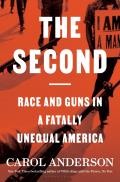Waldstreicher is a professor of history at the City University of New York and author of Slavery’s Constitution: From Revolution to Ratification (2009); Runaway America: Benjamin Franklin, Slavery and the American Revolution (2004); and In the Midst of Perpetual Fetes: The Making of American Nationalism, 1776-1820 (1997). His own review of the long controversies leading up to “The 1619 Project” appeared on the Boston Review in January 2020.
The new review assesses two very different books on American constitutionalism, which lets Waldstreicher make a long running start from Charles Beard’s 1913 An Economic Interpretation of the Constitution of the United States and Warren G. Harding’s tradition-minded counterattack against it.
Eventually that brings us to Wood’s first book The Creation of the American Republic, 1776-1787, published in 1969:
That study won acclaim for highlighting the intellectual and practical dilemmas of republicanism and for seeming to split the difference between celebration and criticism of the founders. Wood argued that, ironically, the course of the 1780s led toward a Madisonian “science of politics” that sought to bury economic conflict in schemes of federalism and representation, and did it so successfully that it created an American political tradition that couldn’t deal honestly with class or money.The Creation of the American Republic was and remains an important book, but in the half-century since it appeared growing numbers of historians have pointed out the limits of its approach.
In this, the young Wood performed a scholarly triple axel. At great length and sophistication, he had offered something to those inclined to celebrate the Constitution, those who criticized it, and those looking for some way between. The republic, simply put, was moderate yet innovative, advanced yet caught up in self-deception.
One factor in that change was simply that new scholars need to develop new ideas. About Cold War-era academics, Waldstreicher writes, “Ever Oedipal, young historians began to make their name by attacking the pieties of their Progressive forebears.” The same process applied to what seemed radical in 1969.
Another is how much America changed in the following decades. When women and people of color play a larger role in society, including the top ranks of our government, economy, and culture, it’s natural to wonder how those individuals were part of the American Revolution. Wood spent little time on those people or issues concerning them. The formal politics of the time excluded them, and he continues to view those politics as most important.
As a result, Waldstreicher and other historians don’t see much new in Wood’s latest book, or in the several that preceded it. It presents the big political documents of the Revolution—the Declaration of Independence and the Constitution—as world-changing while waving away all the ways life didn’t change for most Americans.
In contrast, Anderson’s The Second emphasizes the continuity from colonial-era slave codes through the Second Amendment’s protection of the white male militia to the armed backlash against Reconstruction and civil rights. Wood would probably say her perspective misses the big picture. She would probably say the same of his.

No comments:
Post a Comment